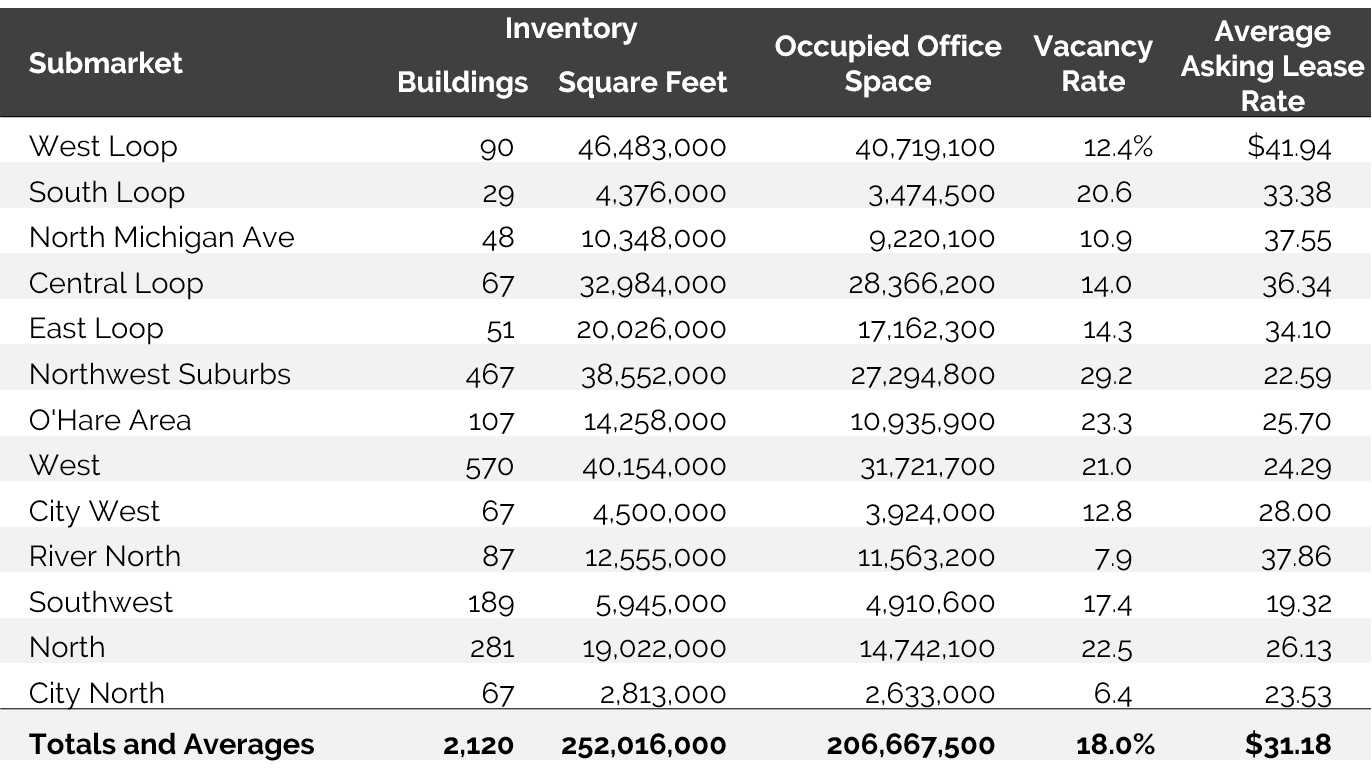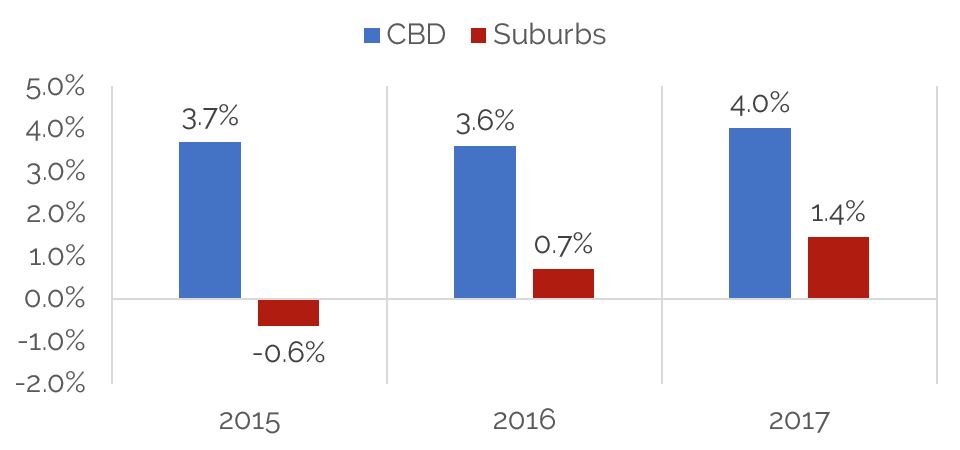By Meghan B. Larmore
Overshadowed by the influx of developments in Downtown Chicago, the suburban Chicago hotel market largely depends on key locations proximate to major transportation infrastructure and anchored demand generators.
Current State and Overall Trends Over the last several years, a wide array of large corporations, which have historically maintained operations in the suburbs, have packed up and relocated their offices to Downtown. Out of the Chicago submarkets listed below, the Northwest Suburbs submarket, which has the second-highest inventory (second to the West submarket), has the highest office vacancy rates in Chicagoland, according to the most recent REIS Report for 2018.
Chicago Submarkets

As local economic development departments work to fill these voids in office vacancy, hotel demand is anticipated to vary based on location, influenced by the proximity to anchored tenants and optimal transportation infrastructure.
New supply in the suburban markets has been minimal, particularly compared to that of Downtown Chicago. With over 73,000 hotel rooms reported in the greater Chicago suburbs, the new supply growth has remained below 2.0% every year since 2015, averaging a mere 0.5% each year. While this may seem low, we must also factor in the hotels being taken out of the market’s inventory, which would increase this figure slightly. The limited pipeline has also contributed to the overall stability of the strong suburban markets, such as the O’Hare and Midway Airport areas.
New Supply Comparison – Chicago Suburbs vs CBD 
Additionally, new supply growth in the suburbs is comparatively lower than most of the major Midwest markets. According to our research and interviews, new supply in the pipeline should remain low over the next several years, as developers continue to remain cautious of some suburban markets following the transition of major employers.
Major Chicago Suburban Markets & Trends
Western Chicago The Western Chicago market encompass cities such as Naperville, Lisle, Oak Brook, Downer’s Grove, and St. Charles. Interstates 88, 290, and 355 serve as primary transportation routes in this region. Western Chicago’s economy is anchored by the healthcare, technology, logistics, and education sectors, with major players including Navistar, Dover Corporation, and DeVry Education Group. Oak Brook was previously home to worldwide headquarters of McDonalds, which moved to Downtown Chicago in 2018.
While the western suburbs have been directly affected by the loss of large corporations, the outlook is generally positive. New developments in this region include the entrance of Amita Health, which added approximately 1,100 jobs to Lisle. Additionally, Get Fresh Produce entered Bartlett, which brought 500 jobs, and the CBRE underwent an expansion in Oak Brook, which brought an additional 325 jobs. As a result, the office vacancy decreased to 15.8% in 2017, compared to the 17.2% in 2016, according to DuPage County Economic Development.
New supply additions within this market have been modest during the past few years, with most of the new supply located in the Naperville area. The development pipeline for the western Chicago suburbs has slowed, as office vacancies continue to be filled and as new supply continues to be absorbed. Many of the established full-service hotels in these markets are undergoing renovations to maintain competitiveness and to gain rate integrity.
Northwest Chicago The Northwest Chicago market is centered on O’Hare International Airport and Interstates 90 and 290. This area benefits from a robust economic base including major technology, manufacturing, and retail entities. It houses the headquarters of Zurich Insurance and Optum Rx, and although Motorola Solutions moved its global headquarters to Downtown Chicago in 2016, the company maintains a large regional office in Schaumburg. We note that the old Motorola Campus is undergoing a major redevelopment that will include office space, multifamily housing, retail, restaurants and entertainment venues. Other major corporations in this area include Comcast, Verizon Wireless, PepsiCo, and Experian.
Perhaps the biggest news as of late for the Chicago suburbs is the proposed $8.5-billion airport expansion at O’Hare International Airport. While this project is still in the early planning stages, the expansion could boost airport traffic from the nearly 78 million passenger traffic to nearly 100 million by 2026. Currently, Chicago O’Hare is reportedly the sixth-busiest airport in the world, according to passenger count. The expansion would have a waterfall effect to the suburbs, not only attracting additional companies to the area, but also spurring significant redevelopment of the transportation infrastructure and, in turn, hotel growth.
However, not all areas of the Northwest Chicago market have a cheery outlook. With the recent announcement of Sears Holdings bankruptcy filing in October 2018, the outlook for Hoffman Estates is still unknown. Should the Chapter 11 bankruptcy restructuring go poorly, the headquarters in Hoffman Estates may add another 2.4 million square feet of office space to the office vacancy in the Northwest Chicago market.
As a direct result of optimal transportation routes, the northwestern Chicago suburbs have experienced the entrance of a significant amount of new hotel supply over the past several years. Northwest Chicago is anticipated to realize the largest new supply growth in the pipeline for Metro Chicago, aside from the CBD. Although Northwest Chicago has the highest office vacancy rate in Metro Chicago, according to REIS, the opportunity exists for large employers to relocate to this area; moreover, the prime locations and lower taxes for the parts of this market that lie outside of Cook County are attractive factors. The resiliency of this market, coupled with the anticipated new developments at the airport, should allow for the absorption of new supply going forward.
Northern Chicago The northern suburbs are home to cities along Interstates 94 and 294, such as Deerfield, Lincolnshire, Vernon Hills, Evanston, Skokie, and Barrington. This area is supported by businesses in the advanced manufacturing, retail, healthcare, financial services, and professional services sectors.
Similar to the larger Metro Chicago trend, the draw of Downtown Chicago has lured companies from this area to relocate to the CBD; consequently, the economy is in a period of fluctuation. In October 2017, major employer Walgreens announced the relocation of its technology offices to Downtown Chicago, relocating several hundred jobs. The company confirmed its intentions to keep its headquarters in Deerfield, albeit with a smaller footprint. Additionally, in September 2018, major pharmaceutical company Takeda announced the closure of its headquarters in Deerfield. The company, which employs approximately 1,000 at its Deerfield location, has approximately 770,000 square feet of office space that will go back on the market. While these fluxes in office vacancies continue, interest in the business parks in the northern suburbs has remained strong. In April 2017, Caterpillar named Deerfield as the new home to its new global headquarters; the move began in 2017 and continued through mid-year 2018, locating approximately 300 employees at the Deerfield location. The relocation filled a vacancy in the Deerfield market provided by the departure of Beam Suntory, a premium spirts maker, to Downtown Chicago.
New supply has been extremely limited as a direct result of the fluctuations with major employers in this Northern Chicago market. Furthermore, the pipeline is minimal, as the outlook remains cautiously optimistic. Going forward, we anticipate that many hotels in the market will undergo major renovations to update aging supply. We note that the Chicago Marriott Lincolnshire Resort reopened in 2017 following a $25-million renovation. The closure of this property for renovations allowed the surrounding hotels in the market to benefit from its displaced guests during this time.
Southwest Chicago The southwestern suburbs include the cities of Orland Park, Joliet, and Burr Ridge. The Southwest Chicago market is anchored by Chicago Midway International Airport, with other economic drivers related to retail, logistics, healthcare, and manufacturing. The ease of transportation along three major interstates (55, 57, and 80) makes the southwestern suburbs especially attractive for regional distribution centers. Companies such as Ulta Beauty, Petco, Grainger, WeatherTech, and Costco maintain large distribution facilities in the area. Furthermore, Amazon has pinpointed this submarket for several large fulfillment and distribution facilities, which have opened in Romeoville, Monee, and Joliet over the past several years. Additionally, the $323-million Improvement Project that is underway at Chicago Midway International Airport continues to boost the passenger counts and the popularity of this facility.
Spurred by these large distribution developments, a significant amount of new supply has entered the market along the Interstate 55 and Interstate 80 corridors. The new supply has been focused on the limited-service and extended-stay hotel products, specifically within the upper-midscale and midscale chain scales. While the pipeline for new supply in this Southwest Chicago market is minimal, the interest has been strong for new hotels developments along the Interstate 55 corridor.
Southland The manufacturing industry is well established in Chicago and throughout the Southland region, which includes cities such as Blue Island, Calumet, and South Holland. Ford Motor Company operates two facilities in the area—the Chicago Assembly in Hegewisch and a large stamping plant in Chicago Heights.
The Chicago Assembly plant benefits from the $900-million modernization project that created a multi-platform manufacturing system, which allows for the plant to adjust its production to match the consumer’s needs. In early 2018, Ford announced plans to eliminate the production of many sedan models, including the Taurus, which is currently being produced at the Chicago Assembly plant. The plant will cease producing the Taurus model in March 2019. Thereafter, the plant will be retooled and transitioned to producing the new Explorer and Lincoln Aviator SUVs; reportedly, this transition will occur without layoffs.
Additionally, BP is an established major employer for this market, maintaining a large refinery in nearby Whiting, Indiana. Other local area manufacturers include Alsip Manufacturing Incorporated, Universal Brush Manufacturing Company, and National Railway Equipment Company. New developments in the area include a new distribution center for Whole Foods, which opened in January 2018 in the Pullman neighborhood. All these companies, and several others, produce significant demand for paid lodging when sales representatives, vendors, and consultants visit the area to meet with local executives or employees.
Within the southern Chicago lodging market, the existing supply is limited, and many older hotels have closed their doors as the economic life of these properties come to an end. The industrial nature of these neighborhoods has historically not supported new hotel development. However, as the existing hotel supply has aged, with many properties losing their flags, the lack of upper-midscale hotels in these neighborhoods has prompted business travelers visiting these areas to stay outside the market. For that reason, developers have expressed interest, although quite cautiously. The inherent risk of developing in these areas has caused many projects to take significant time to come to fruition, if the project is not canceled altogether.
Conclusion Overall, the Chicago suburbs have experienced a period of slow growth, as many of the large employers continue to relocate or restructure. The most optimistic markets remain tied to well-developed transportation infrastructure, such as the airports and major interstates. New supply growth remains minimal, and this trend is anticipated to continue over the next few years, as office vacancies are filled.


